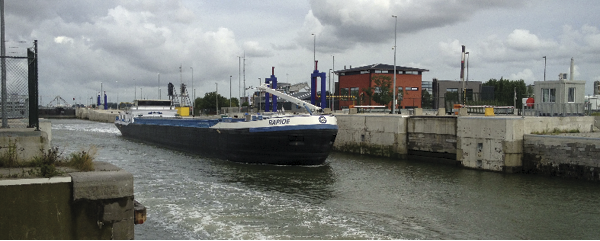Articles
Case Studies

Freight Bill Payment: Meeting the Pepsi Challenge
When Pepsi Logistics Company Inc. (PLCI) was thirsty for an automated system for billing customers, and processing and paying carrier freight bills, it whet its whistle with Epay Manager from Level One Technologies. To understand Plano, Texas-based PLCI’s thirst for automation, consider its size and scope. PLCI manages parent company PepsiCo’s private fleet, one of […]
Read More
Bud Snodgrass: Oils Well That Ends Well
Bud Snodgrass is director of logistics at Universal Lubricants in Wichita, Kansas. He joined the company in 2013. Responsibilities: Distribution, including warehousing and customer service at 17 distribution centers; all inbound and outbound transportation. Experience: Several positions in marine claims, scheduling and distribution, sales, and other areas, Koch Industries; account executive, Trane – Asset Management […]
Read More
Shipment Visibility: SilverStaff Passes the Test
Medical testing lab SilverStaff’s pain points included inbound shipment pickup service and visibility. UPS delivered the remedy.
Read More
Bob Kalland Knows the Drill
Bob Kalland is inventory and logistics manager for Atlas Copco Mining and Rock (MR) Excavation, located in Commerce City, Colo. The company is a unit of Atlas Copco, a Swedish manufacturer of industrial tooling and equipment. He has held this position since 2011. Responsibilities: Managing all inventory and logistics for the MR business. Experience: Inventory […]
Read More
Ax Torres: Plowing Ahead
Ax Torres is outbound shipping supervisor at AGCO Corporation, one of the world’s largest manufacturers of agricultural machinery. Based at the AGCO Parts Division in Batavia, Ill., he has worked in this position since 2013. Responsibilities: Supervise outbound processing and shipping of parts; monitor warehouse functions and supervise materials handling operators; work with carrier procurement […]
Read More
Cloud-based System Furnishes Supply Chain Visibility
Faced with long lead times and potential production delays, Badcock Home Furniture & More sets the table for supply chain efficiency with a cloud-based global logistics solution.
Read More
Jason Shefrin: Asset-Light, By Design
Jason Shefrin is executive vice president, global sourcing, at InterDesign Inc., a major designer and producer of housewares and home fashions. He has worked for the Solon, Ohio-based firm since 2011. Responsibilities: Product development, quality assurance, vendor management, global supply chain operations, logistics and transportation management. Experience: Senior consultant, Cleveland Consulting Associates (CSC Consulting); founding […]
Read More
Heroic Logistics Saves the Day for DC Comics
The DC Comics team leaps into action to create special 3D covers for 52 titles, fighting evil production setbacks along the way.
Read More
Drafting a New Route Planning System
Molson Coors Canada’s new delivery planning system taps routing, pallet building, and truck loading functionality to optimize shipment flow.
Read More
DSW Tries On New SKUs and Stocks
Shoe retailer DSW pairs a new replenishment system with an automated materials handling solution to step up inventory control.
Read More
Sean Vasquez: Heard It Through the Grapevine
Sean Vasquez is EDI and transportation manager at Sun-Maid Growers of California in Kingsburg, Calif. He has worked for the company since 2010, and held his current position since 2013. Responsibilities: Managing all electronic data interchange (EDI) functions; working with the IT department and trading partners to resolve EDI issues; managing transportation policies, rates, and […]
Read More
Magaly Garza Takes on the World
Magaly Garza has worked as international business manager at Vienna, Va.-based home automation and security technology vendor Alarm.com since February 2013. Responsibilities: International operations, including support for supply chain, marketing, pricing, legal, sales, and other areas. Experience: Marketing manager, Cerveceria Cuauhtemoc Moctezuma (now partly owned by Heineken); trade manager, Wine and Spirits Shippers Association; account […]
Read More
Putting Stock in Retail Analytics Tools
For Kleenex maker Kimberly-Clark, managing inventory at retail stores in China was nothing to sneeze at—until it found an analytics solution that delivers comprehensive stock data.
Read More
Mara Gonzalez: Import Expert
Mara Gonzalez is director of purchasing at Vino del Sol, a specialist in Argentinean wines that also markets wines from California, Chile, Japan, and New Zealand. Based in Arlington, Va., Gonzalez has served in her current position since 2011. Responsibilities: Overseeing the entire supply chain, with work focused on purchasing, administration, and regulatory compliance. Experience: […]
Read More
Belgium Travelog: Dispatched from Flanders
Inbound Logistics recently joined Flanders Investment & Trade on a tour of Belgium’s ports and distribution facilities, and learned a little something about running shoes and waffle irons.
Read More
Enhancing Safety Up-N-Down
In-N-Out’s new distribution center serves up an extra helping of loading dock safety and efficiency.
Read More
Chris Carlson: All Charged Up
Chris Carlson is vice president of Batteries Plus Bulbs, a retailer of batteries and light bulbs based in Hartland, Wis., with more than 570 corporate and franchise locations in the United States and Puerto Rico. He has held this position since 2011. Responsibilities: Transportation, warehousing, vendor management, demand planning, part of the China supply chain, […]
Read More
Alana Miedrich: Making Wishes Come True
Alana Miedrich is the inventory and logistics assistant at Kids Wish Network, a children’s charity in Holiday, Fla., that assists children and families experiencing life-altering situations. Alana joined Kids Wish Network in early 2013. Responsibilities: Inbound and outbound transportation of all items donated to Kids Wish Network. Experience: Bookkeeper and marketing, Children of the Nations […]
Read More
Route Planning Software: Mapping a Path to Savings
Poultry supplier George’s scheduling solution delivers meaty efficiency gains.
Read More
Healthcare Logistics Gets a Shot in the Arm
Transporting temperature-sensitive flu vaccines to developing countries can be a headache. A logistics partner that stays cool under pressure provides a cure.
Read More